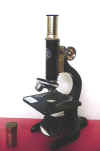|

Science
 Museum
Museum

 SM233
Compound Microscope circa
1955 Light
SM233
Compound Microscope circa
1955 Light
The compound microscope consists of an objective lens close to the
object to be magnified and an eyepiece separated by a tube where the
whole assembly can be moved in relation to the object for focussing the
image seen by the observer.
The objective is of short focal length and may consist of several
individual lenses to correct for spherical and chromatic aberration.
The eyepiece is of longer focal length and usually consists of
two convex lenses separated by a small gap.
The magnification in practice depends on the focal length of the
objective and eyepiece and the distance between them.
The microscope in addition to the lenses requires a means of
illuminating the object by concentrating light from a source via a
mirror at the base and through an iris diaphragm and condensing lens.
The object is placed on a thin glass slide and clamped to a
stage.
There is a rack and pinion coarse focussing mechanism usually
with the addition of a fine focussing adjustment.
A variation of the compound microscope is the travelling microscope,
which is capable of being moved on a vernier scale in any chosen
direction and is used where measurement of small distances to a high
level of precision is required.

|
![]()
 Museum
Museum
![]()
 SM233
Compound Microscope circa
1955 Light
SM233
Compound Microscope circa
1955 Light
![]()